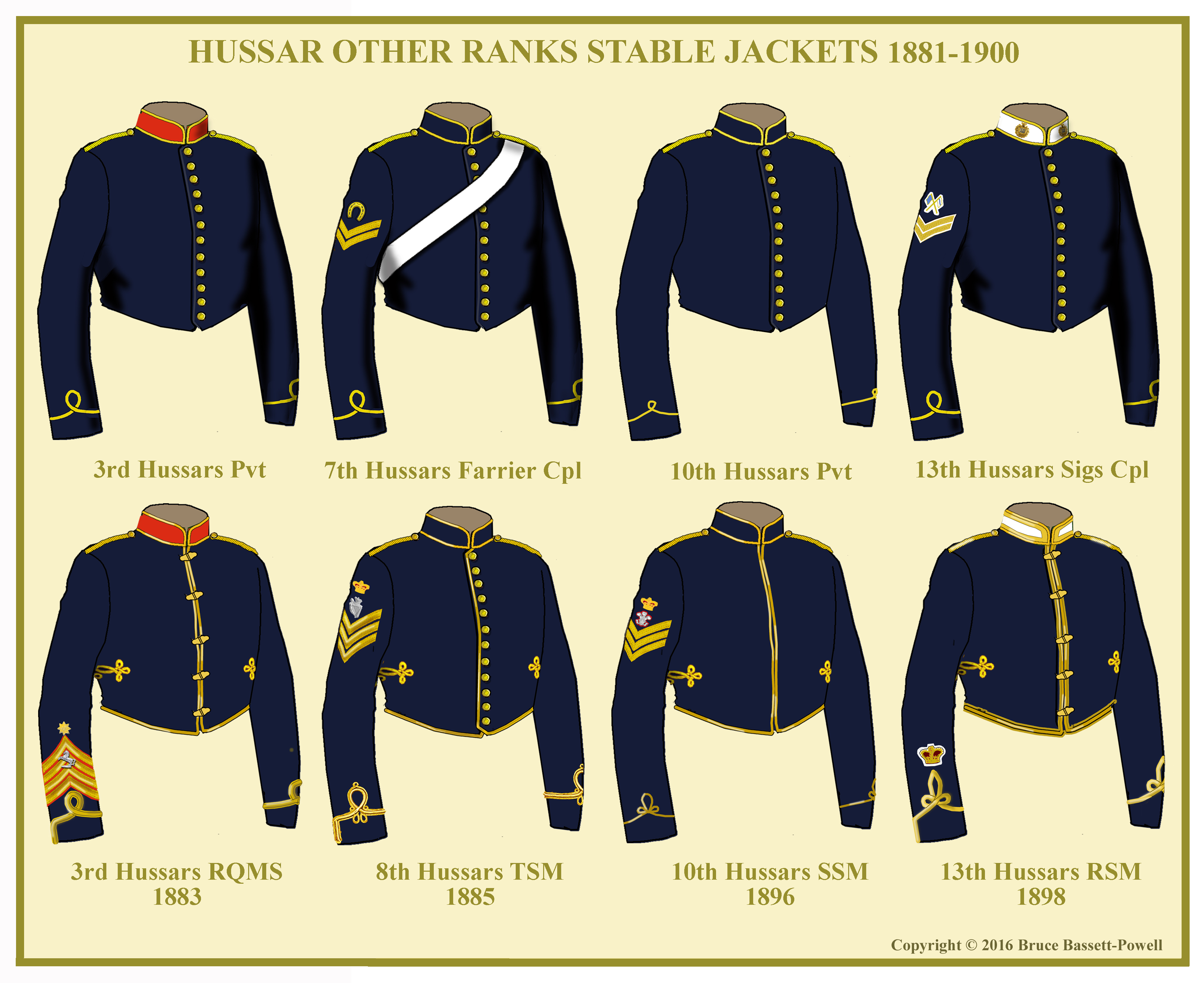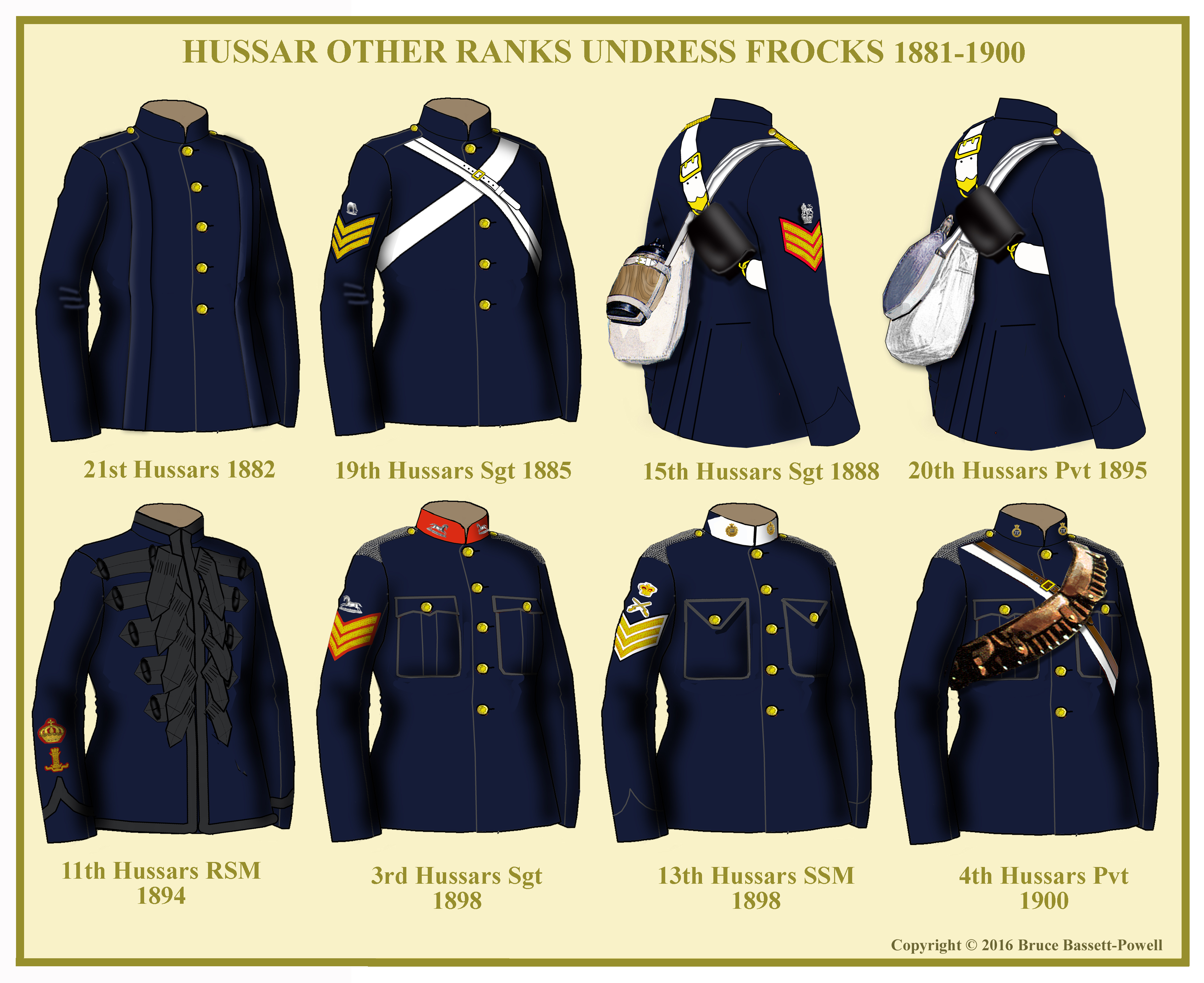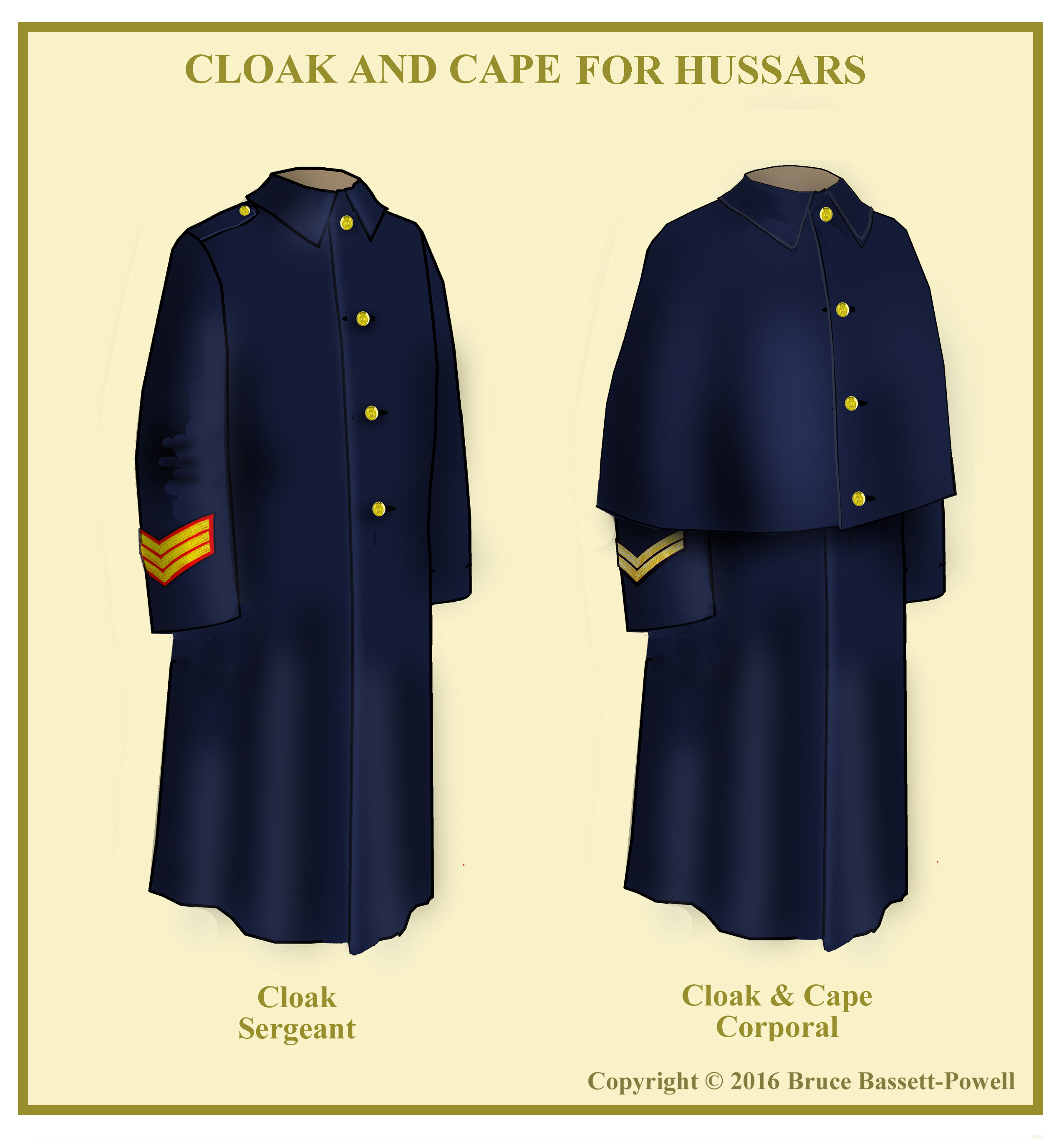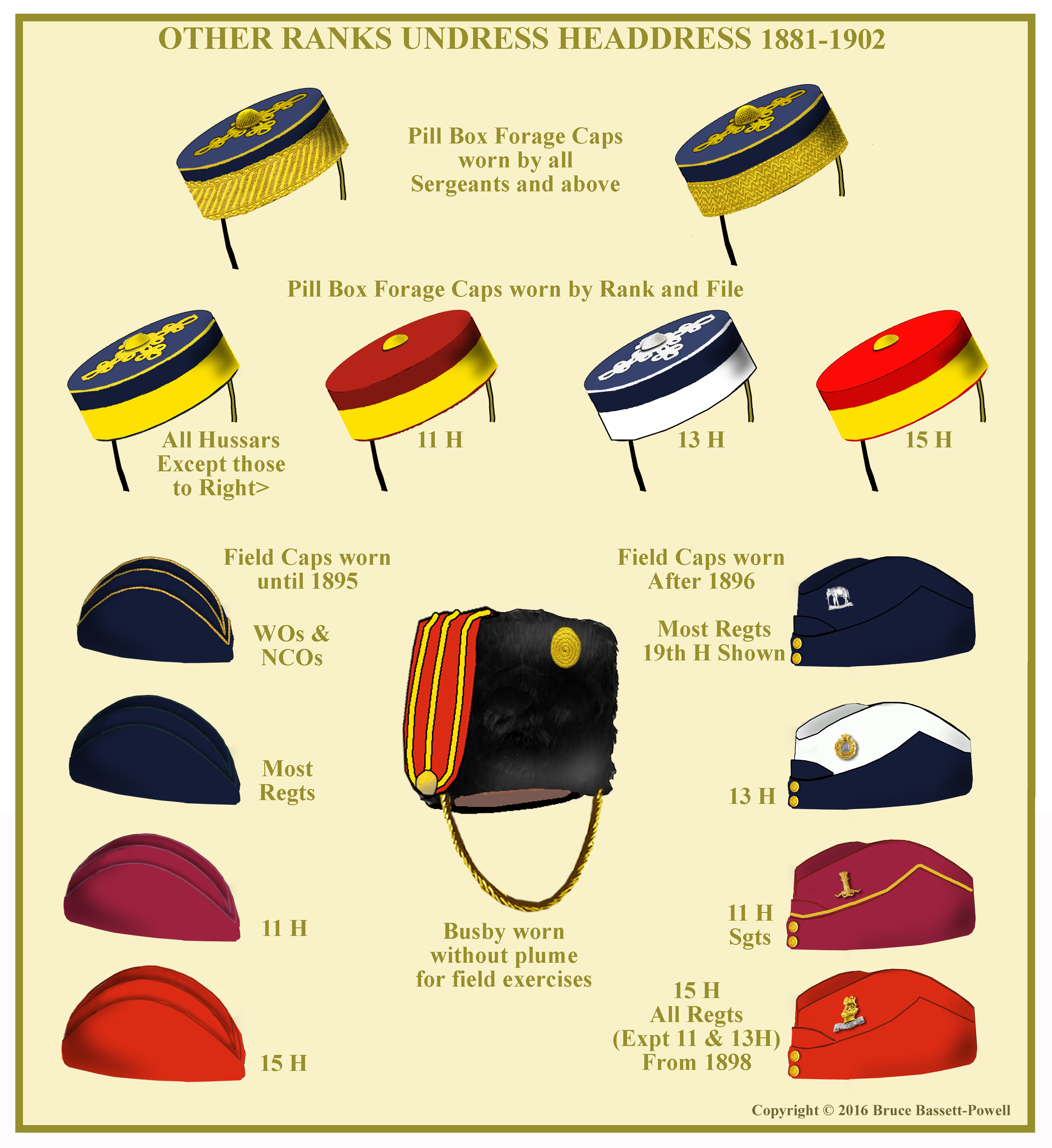UNIFORMS, ARMS & EQUIPMENT - HUSSARS
OTHER RANKS UNDRESS UNIFORMS
HEADDRESS
Like their counterparts in the other cavalry branches, the main form of undress headwear was the pill box cap. (Officially described as the “Round Forage Cap without peak). For most of the regiments, the cap was blue with a worsted yellow band, button and quatrefoil figure on the top. The crown was also edged in yellow. The 11th Hussars had a crimson cap and the 15th Hussars a scarlet cap. Both had yellow bands and buttons, but no figuring or edging on the crown. The 13th Hussars had a white band, button and figuring. The cap was fitted with a thin black leather chinstrap fixed inside the rim.
All warrant officers, 1st & 2nd class sergeants and sergeants wore the same gold banded cap as officers, except that sergeants had only the quatrefoil figure on the top.
The 1878 pattern folding field caps worn by officers for “Active service and peace manouevres” were generally adopted by Warrant Officers and some sergeants mostly without badges but piped on the top and flaps in gold lace. The caps were not worn by the rank and file domestically until the late 1880s and then mostly for stable and barrack duties. They were never worn with the stable jacket. The rank and file caps were plain blue (Crimson for the 11th and scarlet for the 15th).
The 1896 pattern folding cap was general issue throughout the army. Again, for hussars in the colours previously worn except that the 13th Hussars cap had a white body and blue flaps. WOs and Sergeants had gold piping on the flaps only. Badges were worn on the caps from about 1898. In 1898 All hussar regiments except the 11th and 13th were ordered to wear scarlet field service caps.
It should also be noted and it is photographically documented that in full marching order the dress was the busby, without plume with the full dress tunic and full equipment.
STABLE JACKETS
The stable jacket for the rank and file was uniformly standard for every regiment. It was blue with worsted yellow piping around the collar and yellow single loops on the cuffs. The plain front was fastened with 12 brass buttons. For sergeants, the yellow piping and loops were of gold lace. Photographs of the 10th Hussars show that the loop on the cuffs was much smaller than other regiments. The collar of the 3rd Hussars was scarlet and the 13th Hussars white.
Warrant officers and Troop/Squadron Sergeant-Majors had additional gold lace down the front of the jacket and around the bottom, with lace loops with trefoils and Austrian knots on the rear of the jacket. The cuff loops for most regiments were doubled in width. The jackets were fastened with either hooks and eyes or toggles. As usual, there were many variations, some of which were evident for the entire period, others that were not. The 8th Hussars Troop Sergeant-Majors and above had gold loops with tracing, like the officers, on the cuffs and retained the 12 buttons on the front. The 10th Hussars had gold lace trefoils on the cuffs for all 1st and 2nd class Sergeants and later in the century, the Regimental Sergeant-Major had Austrian knots on the cuffs. The RSM of the 13th Hussars had double width trefoils on the cuffs.
Since the introduction of the practical serge frocks, the stable jacket became superfluous and was more often worn for walking out. It was officially abolished in 1897 but like most items of dress in the British Army, it died hard. A great photograph of the 13th Hussars signal troop in 1899 show them all in stable jackets with collar badges!
FIELD SERVICE AND UNDRESS FROCKS
Uniform items for other ranks on active service overseas were not new in the early 1880s. Khaki frocks were almost ubiquitous in India and full dress reserved for only the most illustrious of events. Photographs do show that plain blue frocks were in use for barrack wear. Early examples are in the Norfolk jacket style with fabric strips down each side of the front and back. When the 19th Hussars went to Egypt in 1881 they were wearing plain blue serge frocks. Photographs show that by the 1890s blue frocks were widely in use for hussar regiments for barrack and working dress. Although marching order still included full dress jackets for field exercises some regiments had replaced them with serge frocks. Most still did not have pockets and had shoulder cords in blue or yellow twisted cords and even shoulder straps. The first official five button serge frocks for other ranks appeared in 1894 with plain chest pockets and shoulder straps. By 1896 the frocks were beginning to acquire the shoulder chains which had become popular in India. Some frocks had box pleated breast pockets with scalloped flaps, while others had plain with pointed flaps. The collars on all frocks were blue except for the 3rd Hussars who had a complete red collar and the 13th Hussars who had a pointed white patch on each side of the collar. (Apparently, the 3rd Hussars were ordered to have collar patches as well, but either ignored it or got permission to change it).
The mohair laced patrol jacket does not seem to have been as widely worn by warrant officers of hussars as it was by other cavalry (or for that matter, most branches of the army). RSMs are the most ones likely to have done so and there is a photograph of the RSM of the 11th Hussars in a patrol jacket of officer pattern, but without the Astrakhan fur.
CLOAKS & CAPES
The dark blue cloak and cape were universal for all cavalry including Hussars. It was the same pattern as for officers. In fact Dress Regulations stated that the officer’s pattern was the same as the men’s. It was made of heavy woollen milled cloth reaching down to the ankles. It was designed to cover the soldier and all his equipment when mounted. It had four buttons down the front and one on each shoulder strap. The cape was of the same cloth with four buttons. Unlike the officer’s cape which reached down to the knuckles it reached to just below the elbows to allow for ease of carrying arms etc. Rank insignia was worn on the lower arm (to show when the cape was worn) and was according to clothing regulations to be made of worsted material. However, it appears that most NCOs utilized the same chevrons as were worn on the tunic.






